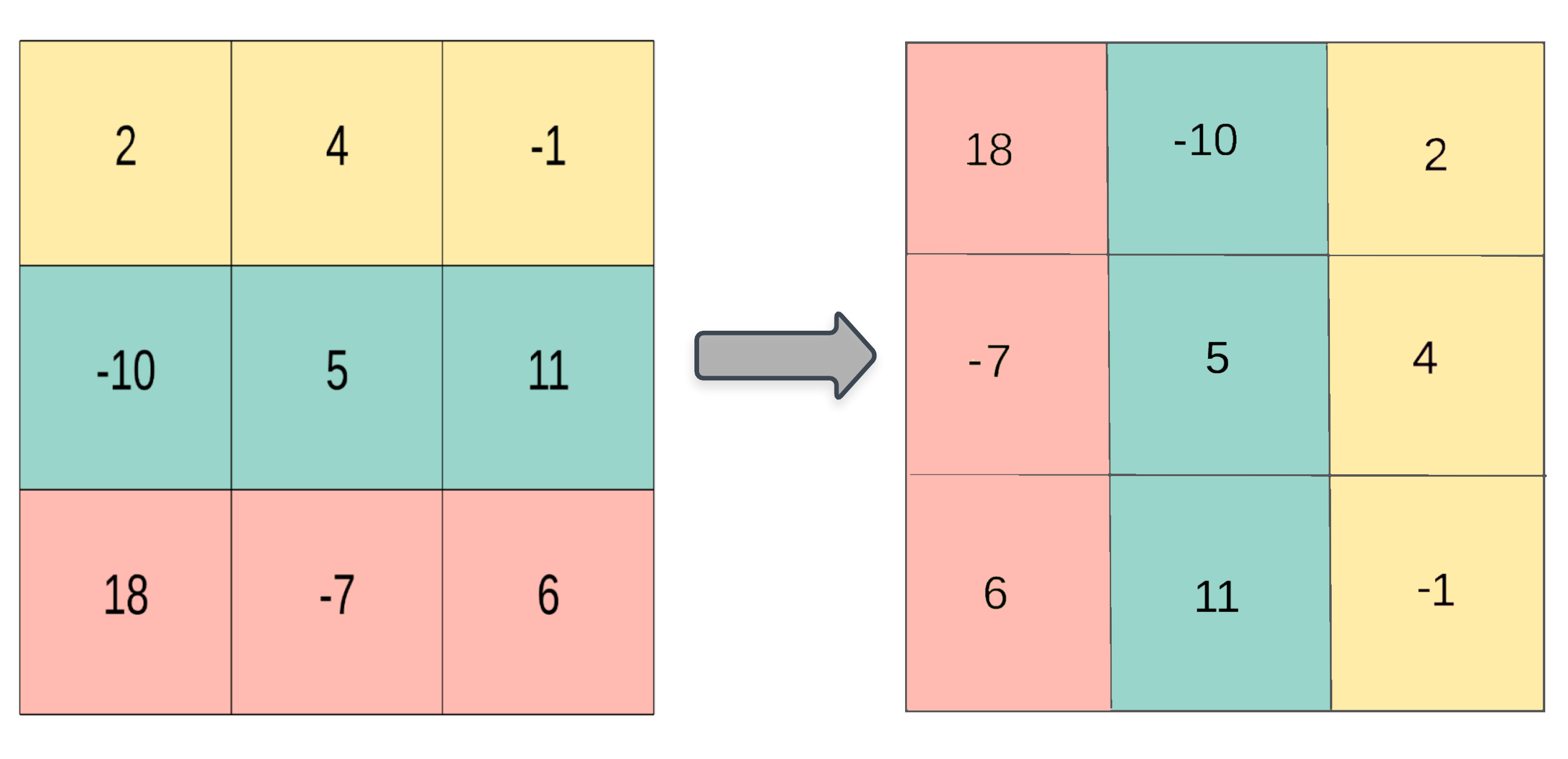I Matrix multiplication
1. Theorem:
The multiplication of two matrices can be defined only when the number of columns of the first matrix A is equal to the number of rows of the other matrix B. If a is m × N matrix and B are n × p matrices whose product C is an M × p matrix.

For example:
2. thinking
1. i and j represent rows and columns respectively, so a two-dimensional matrix should be defined, and its rows and columns are 2
2. Analyze the above formula, let a*b=C, and C is the result of matrix multiplication.
(1) First line of C
The first row and the first column of C are equal to each value of the first row of a multiplied by each value of the first column of b
The first row and the second column of C are equal to each value of the first row of a multiplied by each value of the second column of b
(2) Second line of C
The first column of the second row of C is equal to each value of the second row of a multiplied by each value of the first column of b
The second row and the second column of C are equal to each value of the second row of a multiplied by each value of the second column of b
3. code implementation
#include<stdio.h>
main()
{
int n = 0;
int ret1[2][3] = { {1,0,2}, {-1,3,1} };
int ret2[3][2] = { {3,1},{2,1},{1,0} };
int ret3[2][2];
for (int i = 0; i < 2; i++)
{
for (int j = 0; j < 2; j++)
{
ret3[i][j] = 0; //Initialize to 0 each time
for (int k = 0; k < 3; k++)
{
ret3[i][j] += ret1[i][k] * ret2[k][j];
}
}
}
for (int i = 0; i < 2; i++) //output
{
for (int j = 0; j < 2; j++)
{
printf("%d\t", ret3[i][j]);
}
printf("\n");
}
}II Transpose matrix
1. Definition: m*n matrix

A matrix obtained by exchanging rows and columns

2. Title
Give you a two-dimensional integer array matrix and return the transpose matrix of the matrix.
Transpose of a matrix refers to flipping the main diagonal of the matrix and exchanging the row index and column index of the matrix.

< 1 > idea:
You can exchange row indexes and column indexes directly
< 2 > code
#include<stdio.h>
main()
{
int ret[3][3] = { {2,4,-1},{-10,5,11},{18,-7,6} };//Define a two-dimensional matrix
int newret[3][3]; //Define a new matrix
for (int i = 0; i < 3; i++) //Traverse rows and columns respectively
{
for (int j = 0; j < 3; j++)
{
newret[i][j] = ret[j][i]; //Column index row index exchange
printf("%d\t", newret[i][j]);
}
printf("\n");
}
}< 3 > results

III Matrix rotation

Rotate 90 ° clockwise
1. Ideas
Change of coordinates of 4: (0, 1) - > (1,1)
Other numbers are the same, so we don't list them one by one
For the ^ j element in the ^ i ^ row of the matrix, it appears at the ^ j ^ position in the penultimate ^ i ^ column after rotation.
Translate into code
For matrix elements, matrix[i][j] becomes matrix2[j][n-i-1] after rotation; In the following code, n is 3,
2. Code
<1> According to the above rules, rotate the matrix and put the elements of the matrix into matrix2.
<2> Output rotated matrix
{
int matrix[3][3] = { 2,4,-1,-10,5,11,18,-7,6 };
int matrix2[3][3];
for (int i = 0; i < 3; i++)
{
for (int j = 0; j < 3; j++)
{
matrix2[j][3-i-1] = matrix[i][j]; //Rotate the matrix according to the rules
}
}
for (int i = 0; i < 3; i++)
{
for (int j = 0; j < 3; j++)
{
printf("%d\t", matrix2[i][j]); //Output rotated matrix
}
printf("\n");
}
}
Rotate 90 ° counterclockwise (equivalent to 270 ° counterclockwise)
1. Ideas
4:(0,1)--->(1,0)
Other numbers are the same, so we don't list them one by one
For the ^ j element in the ^ i ^ row of the matrix, it appears at the ^ j ^ position in the penultimate ^ i ^ column after rotation.
Translate into code
For matrix elements, matrix[j][n-i-1] becomes matrix2[i][j] after rotation; In the following code, n is 3,
2. Code
<1> According to the above rules, rotate the matrix and put the elements of the matrix into matrix2.
<2> Output rotated matrix
{
int matrix[3][3] = { 2,4,-1,-10,5,11,18,-7,6 };
int matrix2[3][3];
for (int i = 0; i < 3; i++)
{
for (int j = 0; j < 3; j++)
{
matrix2[i][j] = matrix[j][3-1-i]; //The difference with clockwise rotation
}
}
for (int i = 0; i < 3; i++)
{
for (int j = 0; j < 3; j++)
{
printf("%d\t", matrix2[i][j]);
}
printf("\n");
}
}
180 ° clockwise (equivalent to 180 ° counterclockwise)
1. Ideas
4:(0,1)--->(2,1)
Other numbers are the same, so we don't list them one by one
For the ^ j element in the ^ i ^ row of the matrix, it appears at the ^ j ^ position in the penultimate ^ i ^ column after rotation.
Translate into code
For the elements of the matrix, matrix[i][j] becomes matrix2[n-j-1][n-i-1] after rotation; In the following code, n is 3,
2. Code
<1> According to the above rules, rotate the matrix and put the elements of the matrix into matrix2.
<2> Output rotated matrix
main()
{
int matrix[3][3] = { 2,4,-1,-10,5,11,18,-7,6 };
int matrix2[3][3];
for (int i = 0; i < 3; i++)
{
for (int j = 0; j < 3; j++)
{
matrix2[3 - i - 1][3 - j - 1] = matrix[i][j];
}
}
for (int i = 0; i < 3; i++)
{
for (int j = 0; j < 3; j++)
{
printf("%d\t", matrix2[i][j]);
}
printf("\n");
}
}3. The results are as follows